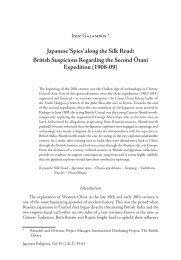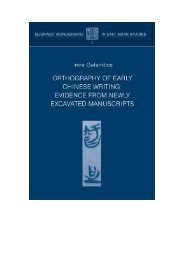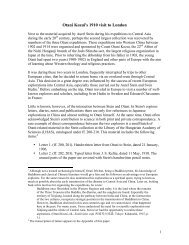8GALAMBOS | SCRIBAL NOTATIONFig. 3: Section of manuscriptOr.8210/S.1547 show<strong>in</strong>g the use ofthe repetition mark. <strong>The</strong> characters <strong>in</strong> the first l<strong>in</strong>e and <strong>in</strong>the second are repeatedFig. 4: Repetition marks for multi-character chongwenA: Or.8210/S.2067 B: 80TBI:009 C: Or.8210/S.116pearance, it rema<strong>in</strong>ed practically unchanged, as abundantlymanifested <strong>in</strong> the Dunhuang and Turfan corpora.Pr<strong>in</strong>cipally speak<strong>in</strong>g, there are two k<strong>in</strong>ds of chongwen:s<strong>in</strong>gle and multiple ones. In the first type, only one characteris repeated, whereas <strong>in</strong> the latter two or more. Whilethis may seem a trivial dist<strong>in</strong>ction, the notation for these <strong>in</strong>actual usage was somewhat different. <strong>The</strong> s<strong>in</strong>gle characterrepetition is simply marked by a small mark <strong>in</strong> place ofthe second character. This mark was sometimes written asor , and probably derived from the pre-Q<strong>in</strong> chongwenmark. Nevertheless, the form is by far the most common<strong>in</strong> Dunhuang and Turfan. An important difference betweenearly and medieval usage was that, <strong>in</strong> the latter, the mark wasplaced with<strong>in</strong> the ma<strong>in</strong> text, <strong>in</strong> place of the omitted secondcharacter. In this way, the repetition mark occupied a fullcharacter space.Or.8210/S.1547, for example, is a manuscript of theChengshilun (*) dated to 512 AD.At the very end of the scroll, we f<strong>in</strong>d the follow<strong>in</strong>g two sentences(given below <strong>in</strong> modern punctuation):Such a man is like a fire burn<strong>in</strong>g the firewood: once the firewoodis exhausted, it will become ext<strong>in</strong>guished; this man isalso like this; because he receives no more, he becomes ext<strong>in</strong>guished.If he ext<strong>in</strong>guishes the three m<strong>in</strong>ds, he will atta<strong>in</strong>eternal liberation from all suffer<strong>in</strong>gs.chongwen:first the character and then a bit later the character . Ineach case, the second characte r is omitted and a mark isplaced <strong>in</strong> its stead (Fig. 3). Although the characters do notform a s<strong>in</strong>gle unit <strong>in</strong> the text grammatically (i.e. , or ) and, <strong>in</strong> a modern punctuated transcription, are separatedfrom each other by a comma or a period, this did not stop themedieval scribe from apply<strong>in</strong>g the chongwen device purelybased on their physical adjacency.In multi-character repetition, the chongwen mark is placedeither underneath the character or at its lower right corner. Anexample of the former usage is Or.8210/S.2067 (Fig. 4/A)where the characters (<strong>in</strong>describable or unspeakable)are repeated <strong>in</strong> the phrase <strong>in</strong>describable and <strong>in</strong>describablemyriads of sentient be<strong>in</strong>gs . What makesthis case different from the s<strong>in</strong>gle chongwen seen above is thatthe three characters are to be read together and only then repeatedas a str<strong>in</strong>g. At least theoretically, it would be possibleto read them repeated one by one as but thiswould produce a mean<strong>in</strong>gless str<strong>in</strong>g of characters. <strong>The</strong>refore,the context is used by the reader for disambiguation.manuscript cultures NEWSLETTER N O 2
GALAMBOS | SCRIBAL NOTATION9<strong>The</strong> other way of mark<strong>in</strong>g multi-character chongwen canbe seen on manuscript 80TBI:009 discovered <strong>in</strong> Turfan (Fig.4/B), where the device is marked with a slanted double dashunderneath the lower right corner of the character. <strong>The</strong> sectionshown on the picture conta<strong>in</strong>s two such cases: <strong>in</strong> the firstl<strong>in</strong>e, we f<strong>in</strong>d Buddha’s habitual exclamation (Excellent, excellent!’); and <strong>in</strong> the third l<strong>in</strong>e, thewords (‘monks and nuns’) arewritten with the characters marked as hav<strong>in</strong>g to be readtwice. This latter case is a wonderful example to show thatthe chongwen device is completely unrelated to the grammaticalstructure of the text and it relies solely on the physicalposition (i.e. adjacency) of characters. In other words,chongwen appears to be concerned only with characters, notwords or sentences.In addition, the doubled chongwen mark is sometimeswritten as a s<strong>in</strong>gle slanted stroke, as can be seen <strong>in</strong> manuscriptOr.8210/S.116 (Fig. 4/C), where the word niepan () is marked <strong>in</strong> this way. In this particular case,the repeated word occurs at the end of one sentence andthe beg<strong>in</strong>n<strong>in</strong>g of another: ‘This is why it is called the Great. In there is no pleasure...’ . In the first sentence, the word is actually ‘Great’is semantically not completely parallel. In this respect, thisusage is similar to that of the words (‘monks and nuns’).Look<strong>in</strong>g through concrete examples of chongwen, it is apparentthat the device was optional <strong>in</strong> medieval manuscripts.Even <strong>in</strong> documents where it occurs, there are places of oftenidentical context where it is not used and the characters are‘spelled out’ <strong>in</strong> their full form. In fact, there are fewer caseswhere chongwen is used than where it is not—it is rather anexception than the norm.REFERENCESHong Mai (1978), (Shanghai:Shanghai guji chubanshe).Huang Zheng (2005), (Shanghai: Shanghai jiaoyu chubanshe).Lowe, Elias Avery (1980), South Italian m<strong>in</strong>iscule (Roma: Edizioni di storia e letteratura).Qiu Xigui (1992a), ‘Jiaguwen zhong chongwen he <strong>hewen</strong>chongfu pianpang de shenglue’ ‘’, <strong>in</strong> Qiu Xigui, . (Beij<strong>in</strong>g:Zhonghua shuju), 141–146.–––– (1992b), ‘Zai tan jiaguwen zhong chongwen de shenglue’ ‘, <strong>in</strong> Qiu Xigui, (Beij<strong>in</strong>g: Zhonghua shuju), 147–150.Shanxi sheng wenwu gongzuo weiyuanhui (1976) (ed.), Houma mengshu (Shanghai: Wenwu).Shen, Baochun (2002), ‘Xi Zhou j<strong>in</strong>wen chongwen xianxiangtanjiu: yi “Y<strong>in</strong>xu j<strong>in</strong>wen jicheng” guilei chongwen wei li’: “”’ , 24: 307–11.Wu Zhenwu (1989), ‘Guxi <strong>hewen</strong> kao (shiba pian)’ ' 17: 268–281.X<strong>in</strong>jiang Weiwu’er Zizhiqu Tulufanxue yanjiuyuan , Wuhan daxue zhongguo san zhijiu shiji yanjiusuo (2007)(eds.), (Beij<strong>in</strong>g: Wenwu).Summary<strong>The</strong> use of <strong>hewen</strong> and chongwen devices <strong>in</strong> medieval manuscriptsis <strong>in</strong>terest<strong>in</strong>g from the po<strong>in</strong>t of view of the transmissionof scribal practices <strong>in</strong> Ch<strong>in</strong>ese history. While the <strong>hewen</strong><strong>in</strong> the medieval corpus shows no similarity to Warr<strong>in</strong>g Statesusage, chongwen rema<strong>in</strong>s a common phenomenon and ismarked <strong>in</strong> a similar way as it was fifteen hundred years earlier.This observation is significant because we do not haveany evidence that such scribal techniques would have beentaught. <strong>The</strong>y are certa<strong>in</strong>ly absent from the l<strong>in</strong>guistic treatises,dictionaries and primers describ<strong>in</strong>g some of the more obviousfeatures of the script (correct character forms, variants,etc). <strong>The</strong>refore, the analogous use of the chongwen deviceand its similar notation arguably demonstrate a direct cont<strong>in</strong>uitybetween pre-Q<strong>in</strong> and Tang-Song manuscript culture.Picture credits:Fig. 1: Trac<strong>in</strong>g from Shanxi 1976: 264.Fig. 2: International Dunhuang Project (http://idp.bl.uk),Or.8210/S.238. Copyright of the British Library.Fig. 3: International Dunhuang Project (http://idp.bl.uk),Or.8210/S.1547. Copyright of the British Library.Fig. 4: Images A and C are from International Dunhuang Project(http://idp.bl.uk), shelfmarks Or.8210/S.2067 and Or.8210/S.116.Copyright of the British Library. Image C is from the publicationX<strong>in</strong>jiang 2007: 11.NEWSLETTER N O 2manuscript cultures







